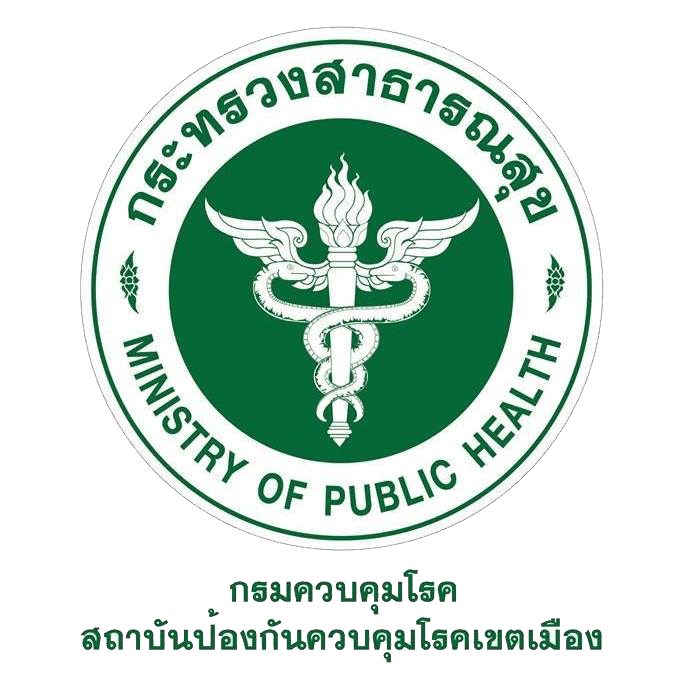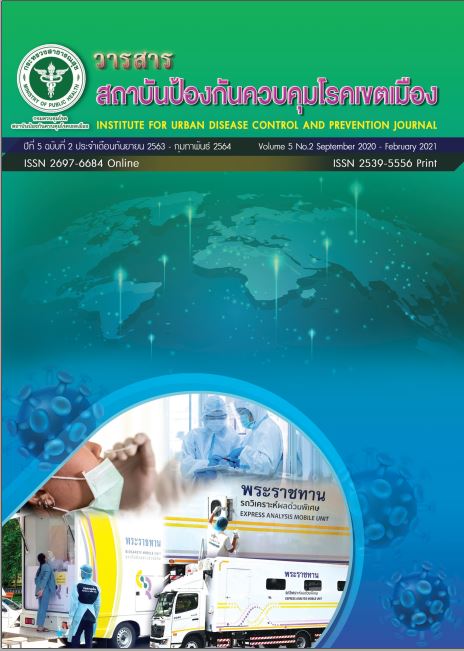ประสิทธิผลของรูปแบบการจัดการความเสี่ยงเชิงรุกเพื่อการเฝ้าระวังภาวะติดเชื้อในกระแสโลหิต ของผู้ป่วยในของโรงพยาบาลแก่งคอย
Main Article Content
บทคัดย่อ
การศึกษากึ่งทดลองแบบกลุ่มเดียววัดผลก่อนและหลังทดลองนี้ มีวัตถุประสงค์เพื่อศึกษาประสิทธิผลของรูปแบบการจัดการความเสี่ยงเชิงรุกเพื่อการเฝ้าระวังภาวะติดเชื้อในกระแสโลหิตของผู้ป่วยในของโรงพยาบาลแก่งคอย เจาะจงเลือกอาสาสมัครการวิจัยจากสหสาขาวิชาชีพผู้ปฏิบัติงานในโรงพยาบาลแก่งคอย จำนวน 84 คน เข้าร่วมกิจกรรมของรูปแบบฯ เป็นระยะเวลา 3 เดือน (กันยายน – พฤศจิกายน 2563) เครื่องมือที่ใช้ในการวิจัย คือ รูปแบบการจัดการความเสี่ยงเชิงรุกเพื่อการเฝ้าระวังภาวะติดเชื้อในกระแสโลหิต แบบสอบถาม และข้อมูลอัตราการติดเชื้อในกระแสโลหิตของผู้ป่วยหอใน ระหว่างปี 2560-2563 และวิเคราะห์ข้อมูลด้วยสถิติ ค่าร้อยละ ค่าเฉลี่ย () ส่วนเบี่ยงเบนมาตรฐาน (S.D.) และเปรียบเทียบความแตกต่างด้วยสถิติ (paired t-test)
ผลการศึกษา พบว่า คะแนนเฉลี่ยความรู้ และพฤติกรรมการเฝ้าระวัง คัดกรอง ดูแลรักษาผู้ป่วยเสี่ยงภาวะติดเชื้อในกระแสโลหิตหลังการใช้รูปแบบฯ สูงกว่าก่อนใช้รูปแบบฯ อย่างมีนัยสำคัญทางสถิติที่ระดับ 0.05 และอัตราการติดเชื้อในกระแสโลหิตของผู้ป่วยหอในหลังการใช้รูปแบบฯ ลดลงก่อนใช้รูปแบบ ร้อยละ 12.37
Article Details
บทความที่พิมพ์ในวารสารสถาบันป้องกันควบคุมโรคเขตเมือง ถือว่าเป็นผลงานวิชาการ งานวิจัยและวิเคราะห์ ตลอดจนเป็นความเห็นส่วนตัวของผู้เขียนเอง ไม่ใช่ความเห็นของสถาบันป้องกันควบคุมโรคเขตเมือง หรือคณะบรรณาธิการแต่ประการใด ผู้เขียนจำต้องรับผิดชอบต่อบทความของตน
เอกสารอ้างอิง
Campaign: International Guidelines for Management of Sepsis and Septic Shock: 2016. Crit Care Med, 45(3),
486-552. doi: 10.1097/CCM.0000000000002255
2. WHO. Sepsis [อินเทอร์เน็ต]. 2017 [สืบค้นเมื่อ 8 ก.ย. 2563]. แหล่งข้อมูล: https://www.who.int/news-
room/fact-sheets/detail/sepsis
3. ประสิทธิ์ อุพาพรรณ. Sepsis. นครนายก: คณะแพทยศาสตร์ มหาวิทยาลัยศรีนครินทรวิโรฒ, 2561.
4. ชูหงส์ มหรรทัศนพงศ์. ผลลัพธ์ของ Surin sepsis treatment protocol ในการจัดการดูแลรักษาภาวะติดเชื้อในกระแส
เลือด [อินเทอร์เน็ต]. 2012 [สืบค้นเมื่อ 9 ก.ย. 2563]. แหล่งข้อมูล:
http://www.smj.ejnal.com/e-journal/showdetail/?show_detail=T&art_id=1745
5. สำนักตรวจราชการกระทรวงสาธารณสุข. แผนการตรวจราชการกระทรวงสาธารณสุข ประจำปีงบประมาณ พ.ศ. 2561.
นนทบุรี: กองตรวจราชการ, 2560.
6. สุณีรัตน์ คงเสรีพงศ์ และดวงมณี เลาหประสิทธิพร. แนวทางการรักษาผู้ป่วยผู้ใหญ่ที่มีภาวะ Severe sepsis/septic
shock โรงพยาบาลศิริราช คณะแพทยศาสตร์ศิริราชพยาบาล มหาวิทยาลัยมหิดล (ฉบับปรับปรุง พ.ศ. 2556).
กรุงเทพมหานคร: คณะแพทยศาสตร์ศิริราชพยาบาล, 2556.
7. William Edwards Deming. “วงจรการบริหารงานคุณภาพ (PDCA: Deming Cycle) ”.[อินเทอร์เน็ต]. 2017
[สืบค้นเมื่อ 9 ก.ย. 2563]. แหล่งข้อมูล: https://www.ftpi.or.th/2015/2125
8. อรพินทร์ ชูชม. การวิจัยกึ่งทดลอง Quasi – Experimental Research. วารสารพฤติกรรมศาสตร์ 2555, 15(1), 1-15.
9. สำนักงานพัฒนาวิทยาศาสตร์และเทคโนโลยีแห่งชาติ (สวทช.). การทบทวนหลังทำงาน หรือหลังปฏิบัติ หรือหลัง
กิจกรรม (After Action Review-AAR) [อินเทอร์เน็ต]. 2563 [สืบค้นเมื่อ 3 ก.ย. 2563]. แหล่งข้อมูล:
https://www.nstda.or.th/th/nstda-knowledge/144-km-knowledge/3282-after-action-review
10. อัมพร ไหลประเสริฐ. เอกสารประกอบการสอนวิชา การบริหารพยาบาล เรื่อง การวิเคราะห์องค์กรโดยใช้ เทคนิค
SWOT analysis. [อินเทอร์เน็ต]. 2563 [สืบค้นเมื่อ 4 ก.ย. 2563]. แหล่งข้อมูล:
http://61.19.86. 230/manage/Plan_pic/20120923145921.doc.
11. มัณทนา จิระกังวาน ชลิดา จันเทพา และเพ็ญนภา บุบผา. การพัฒนารูปแบบการพยาบาลผู้ป่วยติดเชื้อในกระแส
เลือดอย่างรุนแรง (Severe sepsis) ในโรงพยาบาลศรีสะเกษ.วารสารกองการพยาบาล 2558, 42(3), 9-33.
12. พรนภา วงศ์ธรรมดี, รัชนี นามจันทรา, และวารินทร์ บินโฮเซ็น. คุณภาพการจัดการดูแลผู้ป่วยที่มีภาวะติดเชื้อใน
กระแสเลือดที่หน่วยงานอายุรกรรม. วารสารการพยาบาลและสุขภาพ สสอท 2562, 1(1), 33-49.
13. อัญชลี มากบุญส่ง. ปัจจัยที่สัมพันธ์กับการนำใช้ SOS Score ในกลุ่มผู้ป่วยติดเชื้อในกระแสเลือดของพยาบาลวิชาชีพ
กลุ่มงานอายุรกรรม โรงพยาบาลวชิระภูเก็ต [อินเทอร์เน็ต]. 2563 [สืบค้นเมื่อ 7 พ.ย. 2563]. แหล่งข้อมูล:
http://vachiraphuket.go.th/index.php?name=knowledge&file=readknowledge&id=630
14.ทิฏฐิ ศรีวิสัย และวิมล อ่อนเส็ง. ภาวะช็อกจากการติดเชื้อ: ความท้าทายของพยาบาลฉุกเฉิน. วารสารวิทยาลัย
พยาบาลบรมราชชนนี อุตรดิตถ์ 2560, 9(2), 152-162.
15. กำธร มาลาธรรม และยงค์ รงค์รุ่งเรือง.คู่มือปฏิบัติการป้องกันและควบคุมการติดเชื้อในโรงพยาบาล (พิมพ์ครั้งที่ 2). นนทบุรี:
สำนักพิมพ์อักษรกราฟฟิคแอนด์ดีไซน์ ; 2560.
16. ฑิตยา วาระนัง. ผลลัพธ์ของการใช้แนวปฏิบัติการดูแลผู้ป่วยที่มีภาวะติดเชื้อในกระแสโลหิต โรงพยาบาลฝาง จังหวัด
เชียงใหม่. เชียงรายเวชสาร 2562, 11(2), 1-8.
17. สุทธิชัย แก้วหาวงค์ และดลวิวัฒน์ แสนโสม. ผลของการปฏิบัติการพยาบาลตามโปรแกรมการพยาบาลผู้ป่วย
ในระยะ 1 ชั่วโมงแรก ในผู้ป่วยกลุ่มอาการติดเชื้อในกระแสเลือดที่เข้ารับการรักษาในงานอุบัติเหตุฉุกเฉิน. วารสารการ
พยาบาลและการดูแลสุขภาพ 2563, 38(1), 196-206.


